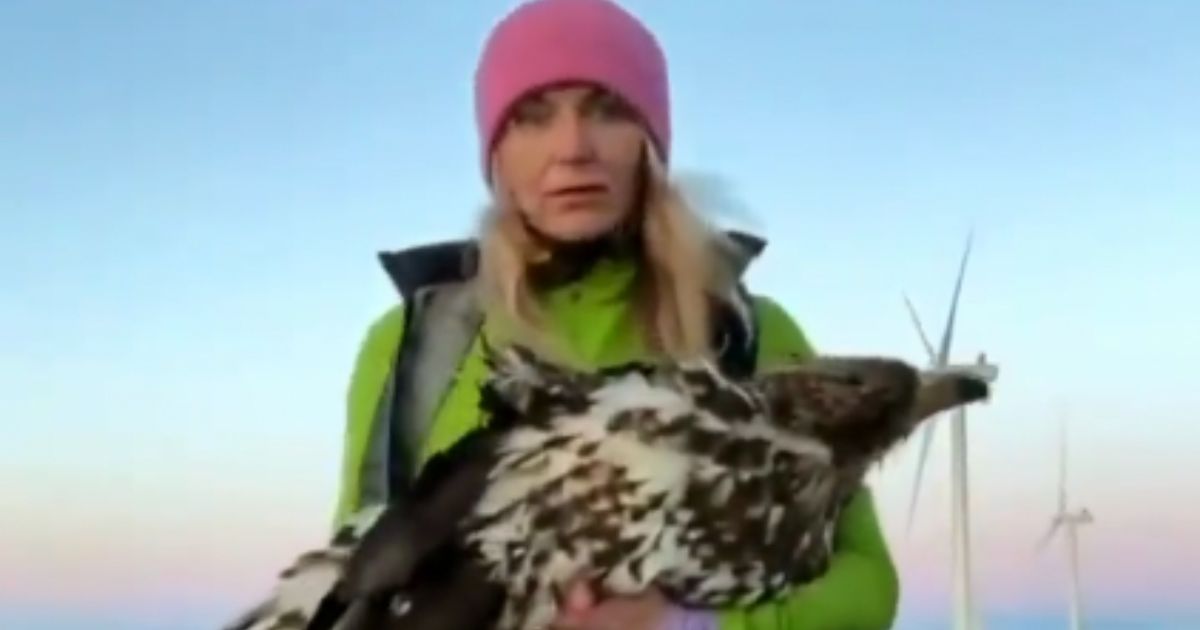One of the reasons America banned the pesticide DDT is because scientists believed the chemical was endangering the bald eagle by thinning its eggs to the point where they couldn’t incubate.
Whether or not this was the case remains a matter of debate — but, the point is that the United States went out of its way to ban a chemical which eradicated disease-carrying parasitic insects because of our concern for the bald eagle. Thanks, environmentalists.
A half-century after DDT was banned, bald eagles (and other birds) are facing another man-made threat that’s wiping them out en masse. This time, though, environmentalists are cheering it on.
Seem a bit odd to you? Perhaps it’ll make a bit more sense when you find out that what’s killing the birds is considered sacrosanct to the Nissan Leaf crowd: wind turbines.
The issue went viral after Arizona GOP gubernatorial nominee Kari Lake quote-tweeted a video of an eagle with its wing cut off, all thanks to a wind turbine.
“BILLIONS of birds—including thousands of American Bald Eagles” are affected by this, Lake asserted.
“Why aren’t the environmentalists up-in-arms over this?”
WARNING: The following video contains graphic footage that some viewers will find disturbing.
BILLIONS of birds—including thousands of American Bald Eagles.
Why aren’t the environmentalists up-in-arms over this? https://t.co/7C1Nsxxsxe
— Kari Lake (@KariLake) September 11, 2022
The video isn’t new; according to Fieldsports News, the clip — which featured a protected sea eagle that had been mortally wounded by a turbine — was taken in May of 2021 in one of Norway’s largest wind turbine fields.
[firefly_embed]
[/firefly_embed]
The video may not be new, but the problem isn’t, either.
Earlier this year, a white-tailed sea eagle that researchers were tracking via a GPS locator died after flying into a wind turbine in the Netherlands.
“Just before 11 a.m., the animal was hit by the rotors of one of the turbines and landed in the field next to it,” Dutch website Nature Today reported, according to a computer translation.
“The transmitter’s accelerometer showed that the bird was not immediately dead after the impact. The bird was still moving between 11 a.m. and 12 noon.
“After that, the transmitter’s sensor stopped detecting movement, and the temperature dropped rapidly. During the discovery of the cadaver, on February 1, 2022, it was confirmed that the bird was still alive immediately after the collision. Both claws were filled with heavy clay, which indicates that the animal struggled to keep itself upright for another hour.”
Charming. According to Dutch News, the white-tailed eagle is being reintroduced into the Netherlands; while there are over a dozen breeding pairs, that still means the species’ foothold in the country is tenuous.
There are bird-detection systems that could potentially stop incidents like this, the former Dutch agriculture minister Carola Schouten said, but protection measures are left to provincial authorities — and, after all, such measures cost money. Given that green energy isn’t cheap to begin with, that’s an issue.
So are dead birds, though. Joel Merriman, wind specialist at the American Bird Conservancy, created a model of bird deaths via wind turbines in 2021. His conclusion was that 1.17 million birds are killed by the windmills each year. All this for a form of energy that provides inconsistent power and constantly underperforms expectations.
But, of course, the impact of this was minimized: “This is a lot of birds, but it is only 0.016 percent of the estimated 7.2 billion birds that live in the U.S.,” Energy Monitor reported.
“It is also significantly less than the 5 – 6.8 million killed each year by communication towers, the 60 – 80 million killed by automobiles, the 67 – 90 million killed by pesticides, or the 365 million to one billion killed by cats each year in the U.S., according to a study published in Nature.”
Yes, but there’s a bit of a difference between Fluffy killing a robin in the backyard and a wind turbine ripping the wing off of a massive eagle. Moreover, it raises serious questions about what happens if a wind farm is — despite the best laid plans and studies of bird patterns — inadvertently constructed in a location which threatens vulnerable avian species. Which one goes: the expensive green energy project or the endangered bird?
Of course, no one who claims to care about the environment wants to talk about this. You’ve got to break a few eggs to make John Kerry’s clean-energy omelette, after all.
I mean, sometimes those eggs have already been hatched and have eight-foot wingspans, but you’ve still gotta break ’em. Environmentalism!
This article appeared originally on The Western Journal.

























 Continue with Google
Continue with Google